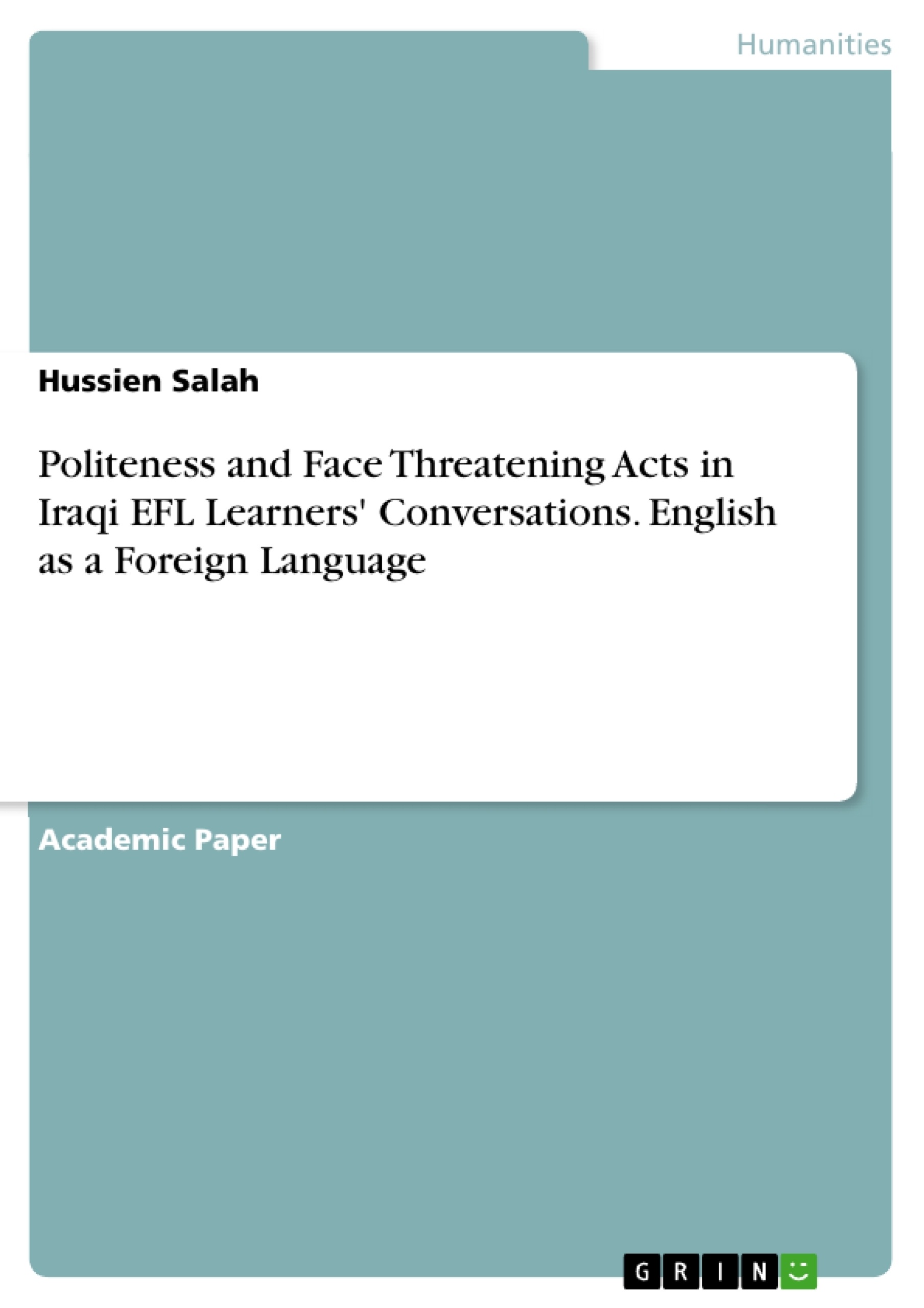This study examines the use of face threatening acts and politeness of the Iraqi EFL learners in their conversations. The study reviews a theoretical background to the theory and the data are analysed according to an eclectic model. The study applies the model to one hundred of Iraqi university students’ conversations. The study tries to detect, analyse and discuss the type and the number of politeness strategies and face threatening acts used by the students and to testify the four hypotheses that are postulated in the study. The hypotheses of the study include that the most politeness strategy used by the students is negative politeness and there is a misuse of the face threatening acts by Iraqi EFL learners.
"Face" is a linguistic term that is used in semantics, pragmatics, sociolinguistics, as well as sociology, psychology, and political science. The term is now used in different cultures in a metaphorical sense to mean the reputation or the standing in the society. Goffman defines the term as "the positive image you seek to establish in social interactions". Brown and Levinson believe that in performing a particular speech act in a particular context, the face-wants of the participants are threatened and politeness takes place to modify these face threatening acts. Furthermore, the counteractions that the participants make when they fail to perform a self-image competently are called "face-work". J. Thomas indicates that politeness makes an equality in any social interaction. Politeness is a pragmatic theory that means "saying the socially correct thing…(and) is developed by societies in order to reduce friction in personal interaction". Brown and Levinson's theory of politeness is still the basis for the latter theoretical and empirical works on this theory.
Table of Contents
- Introduction
- Literature Review
- Politeness
- Face-Threatening Acts
- Research Methodology
- The Selection of Informants
- Data Analysis and Discussion
- Conclusion
- References
Objectives and Key Themes
This study aims to investigate the use of face threatening acts (FTAs) and politeness strategies in conversations among Iraqi EFL learners. By drawing upon the theories of Brown and Levinson (1978), Roberts (1992), and Hoebe (2001), the research analyzes one hundred conversations to determine how politeness is employed and whether the model accurately predicts the strategies used by these learners.
- The application of Brown and Levinson's politeness model to Iraqi EFL learners' conversational strategies.
- The prevalence of negative politeness strategies in the data.
- The role of participant characteristics and situational factors in FTA selection.
- The potential misuse of FTAs by Iraqi EFL learners.
- The comparison of expected politeness with observed politeness in conversations.
Chapter Summaries
- Introduction: The study introduces the concept of "face" as a linguistic term with implications for semantics, pragmatics, sociolinguistics, and other fields. It defines face as an individual's reputation or standing within society and explains how face-threatening acts (FTAs) can disrupt this image. The study also outlines the theory of politeness as a means of mitigating FTAs and maintaining face in social interactions.
- Literature Review: This chapter explores the theoretical foundations of face and politeness, drawing on key figures like Brown and Levinson (1987) and their model of positive and negative face. It discusses different approaches to defining and understanding politeness and how it relates to face management.
- Politeness: This section delves into the concept of politeness, tracing its linguistic roots and examining various definitions from different academic fields. The chapter highlights politeness as a strategic mechanism to avoid conflict and promote cooperation in social interactions.
- Face-Threatening Acts: This chapter explores the nature of FTAs, defining them as communication acts that potentially threaten an individual's self-image. The study examines the different types of FTAs, including those that threaten a hearer's positive or negative face, and those that threaten a speaker's own face.
- Research Methodology: This chapter outlines the methodology employed in the study, including the chosen model for analysis, the selection of informants, and the data collection and analysis process. It describes the different strategies used to assess politeness, such as bald on record, positive politeness, negative politeness, and off record.
Keywords
The study centers on key concepts such as face, face-threatening acts, politeness, negative politeness, positive politeness, and politeness strategies. It focuses on the application of Brown and Levinson's model to Iraqi EFL learners' conversations and explores the relationship between politeness strategies, social distance, power dynamics, and the severity of the FTA.
- Citar trabajo
- Hussien Salah (Autor), 2019, Politeness and Face Threatening Acts in Iraqi EFL Learners' Conversations. English as a Foreign Language, Múnich, GRIN Verlag, https://www.grin.com/document/503307



